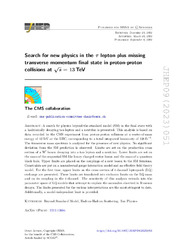Search for new physics in the τ lepton plus missing transverse momentum final state in proton-proton collisions at √s = 13 TeV
| dc.contributor.author | Tumasyan, A. | |
| dc.contributor.author | Işıldak, Bora | |
| dc.date.accessioned | 2024-02-01T08:56:36Z | |
| dc.date.available | 2024-02-01T08:56:36Z | |
| dc.date.issued | 2023-09 | |
| dc.identifier.issn | 1029-8479 | en_US |
| dc.identifier.uri | http://hdl.handle.net/10679/9116 | |
| dc.identifier.uri | https://link.springer.com/article/10.1007/JHEP09(2023)051 | |
| dc.description.abstract | A search for physics beyond the standard model (SM) in the final state with a hadronically decaying tau lepton and a neutrino is presented. This analysis is based on data recorded by the CMS experiment from proton-proton collisions at a center-of-mass energy of 13 TeV at the LHC, corresponding to a total integrated luminosity of 138 fb −1. The transverse mass spectrum is analyzed for the presence of new physics. No significant deviation from the SM prediction is observed. Limits are set on the production cross section of a W′ boson decaying into a tau lepton and a neutrino. Lower limits are set on the mass of the sequential SM-like heavy charged vector boson and the mass of a quantum black hole. Upper limits are placed on the couplings of a new boson to the SM fermions. Constraints are put on a nonuniversal gauge interaction model and an effective field theory model. For the first time, upper limits on the cross section of t-channel leptoquark (LQ) exchange are presented. These limits are translated into exclusion limits on the LQ mass and on its coupling in the t-channel. The sensitivity of this analysis extends into the parameter space of LQ models that attempt to explain the anomalies observed in B meson decays. The limits presented for the various interpretations are the most stringent to date. Additionally, a model-independent limit is provided. | en_US |
| dc.description.sponsorship | Individuals have received support from the Marie-Curie program and the European Research Council and Horizon 2020 Grant, contract Nos. 675440, 724704, 752730, 758316, 765710, 824093, 884104, and COST Action CA16108 (European Union); the Leventis Foundation; the Alfred P. Sloan Foundation; the Alexander von Humboldt Foundation; the Belgian Federal Science Policy Office; the Fonds pour la Formation a la Recherche dans l'Industrie et dans l'Agriculture (FRIA-Belgium); the Agentschap voor Innovatie door Wetenschap en Technologie (IWT-Belgium); the F.R.S.-FNRS and FWO (Belgium) under the "Excellence of Science -EOS" -be.h project n. 30820817; the Beijing Municipal Science & Technology Commission, No. Z191100007219010; the Ministry of Education, Youth and Sports (MEYS) of the Czech Republic; the Hellenic Foundation for Research and Innovation (HFRI), Project Number 2288 (Greece); the Deutsche Forschungsgemeinschaft (DFG), under Germany's Excellence Strategy -EXC 2121 "Quantum Universe" -390833306, and under project number 400140256 -GRK2497; the Hungarian Academy of Sciences, the New National Excellence Program -UNKP, the NKFIH research grants K 124845, K 124850, K 128713, K 128786, K 129058, K 131991, K 133046, K 138136, K 143460, K 143477, 2020-2.2.1-ED-2021-00181, and TKP2021-NKTA-64 (Hungary); the Council of Science and Industrial Research, India; the Latvian Council of Science; the Ministry of Education and Science, project no. 2022/WK/14, and the National Science Center, contracts Opus 2021/41/B/ST2/01369 and 2021/43/B/ST2/01552 (Poland); the Fundacao para a Ciencia e a Tecnologia, grant CEECIND/01334/2018 (Portugal); the National Priorities Research Program by Qatar National Research Fund; MCIN/AEI/10.13039/501100011033, ERDF "a way of making Europe", and the Programa Estatal de Fomento de la Investigacion Cientifica y Tecnica de Excelencia Maria de Maeztu, grant MDM-2017-0765 and Programa Severo Ochoa del Principado de Asturias (Spain); the Chulalongkorn Academic into Its 2nd Century Project Advancement Project, and the National Science, Research and Innovation Fund via the Program Management Unit for Human Resources & Institutional Development, Research and Innovation, grant B05F650021 (Thailand); the Kavli Foundation; the Nvidia Corporation; the SuperMicro Corporation; the Welch Foundation, contract C-1845; and the Weston Havens Foundation (U.S.A.). | |
| dc.language.iso | eng | en_US |
| dc.publisher | Springer | en_US |
| dc.relation.ispartof | Journal of High Energy Physics | |
| dc.rights | openAccess | |
| dc.rights | Attribution 4.0 International | |
| dc.rights.uri | https://creativecommons.org/licenses/by/4.0/ | |
| dc.title | Search for new physics in the τ lepton plus missing transverse momentum final state in proton-proton collisions at √s = 13 TeV | en_US |
| dc.type | Article | en_US |
| dc.description.version | Publisher version | en_US |
| dc.peerreviewed | yes | en_US |
| dc.publicationstatus | Published | en_US |
| dc.contributor.department | Özyeğin University | |
| dc.contributor.authorID | (ORCID 0000-0002-0283-5234 & YÖK ID 124605) Işıldak, Bora | |
| dc.contributor.ozuauthor | Işıldak, Bora | |
| dc.creator | The CMS Collaboration | |
| dc.identifier.volume | 2023 | en_US |
| dc.identifier.issue | 9 | en_US |
| dc.identifier.wos | WOS:001090971800001 | |
| dc.identifier.doi | 10.1007/JHEP09(2023)051 | en_US |
| dc.subject.keywords | Beyond Standard Model | en_US |
| dc.subject.keywords | Hadron-Hadron Scattering | en_US |
| dc.subject.keywords | Tau Physics | en_US |
| dc.identifier.scopus | SCOPUS:2-s2.0-85182846237 | |
| dc.relation.publicationcategory | Article - International Refereed Journal - Institutional Academic Staff |
Files in this item
This item appears in the following Collection(s)
Share this page




